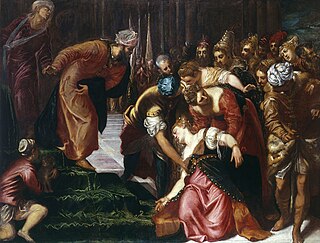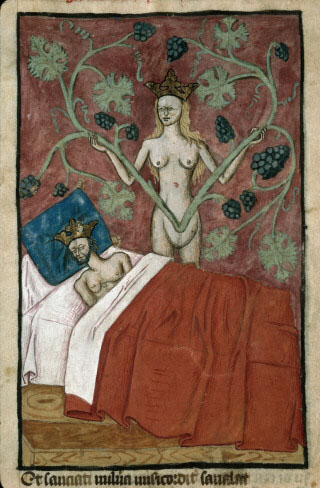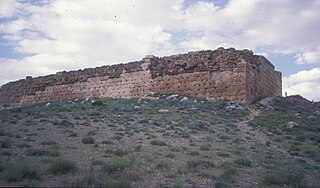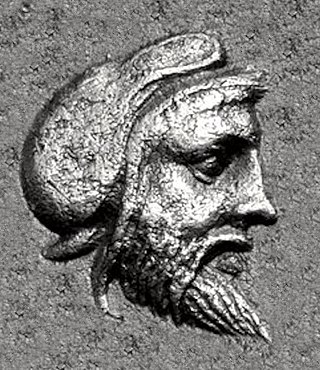
Xerxes I, commonly known as Xerxes the Great, was a Persian ruler who served as the fourth King of Kings of the Achaemenid Empire, reigning from 486 BC until his assassination in 465 BC. He was the son of Darius the Great and Atossa, a daughter of Cyrus the Great. In Western history, Xerxes is best known for his invasion of Greece in 480 BC, which ended in Persian defeat. Xerxes was designated successor by Darius over his elder brother Artobazan and inherited a large, multi-ethnic empire upon his father's death. He consolidated his power by crushing revolts in Egypt and Babylon, and renewed his father's campaign to subjugate Greece and punish Athens and its allies for their interference in the Ionian Revolt. In 480 BC, Xerxes personally led a large army and crossed the Hellespont into Europe. He achieved victories at Thermopylae and Artemisium before capturing and razing Athens. His forces gained control of mainland Greece north of the Isthmus of Corinth until their defeat at the Battle of Salamis. Fearing that the Greeks might trap him in Europe, Xerxes retreated with the greater part of his army back to Asia, leaving behind Mardonius to continue his campaign. Mardonius was defeated at Plataea the following year, effectively ending the Persian invasion.

Ahasuerus is a name applied in the Hebrew Bible to three rulers of Ancient Persia and to a Babylonian official first appearing in the Tanach in the Book of Esther and later in the Christian Book of Tobit. It is a transliteration of either Xerxes I or Artaxerxes; both are names of multiple Achaemenid dynasty Persian kings.

Leonidas I was a king of the Greek city-state of Sparta, and the 17th of the Agiad line, a dynasty which claimed descent from the mythical demigod Heracles. Leonidas I was a son of King Anaxandridas II. He succeeded his half-brother King Cleomenes I to the throne in c. 489 BCE. His co-ruler was King Leotychidas. He was succeeded by his son, King Pleistarchus.

Megabyzus was an Achaemenid Persian general, son of Zopyrus, satrap of Babylonia, and grandson of Megabyzus I, one of the seven conspirators who had put Darius I on the throne. His father was killed when the satrapy rebelled in 484 BCE, and Megabyzus led the forces that recaptured the city, after which the statue of the god Marduk was destroyed to prevent future revolts. Megabyzus subsequently took part in the Second Persian invasion of Greece. Herodotus claims that he refused to act on orders to pillage Delphi, but it is doubtful such orders were ever given.

Cyaxares was the third king of the Medes. Cyaxares ascended to the throne in 625 BCE, after his father Phraortes lost his life in a battle against the Assyrians.

Mandane was a Median princess and, later, the queen consort of the Persian king Cambyses I and the mother of Cyrus the Great, the founder of the Achaemenid Empire. The name likely originates from the Old Iranian *Mandanā-, which means “delighting, cheerful”.
Vishtaspa, hellenized as Hystáspes, may refer to:

Astyages was the last king of the Median kingdom, reigning from 585 to 550 BCE. The son of Cyaxares, he was dethroned by the Persian king Cyrus the Great.
The Median dynasty was, according to the ancient Greek historian Herodotus, a dynasty composed of four kings who ruled for 150 years under the Median Empire. If Herodotus' story is true, the Medes were unified by a man named Deioces, the first of the four kings who would rule the Median Empire, a mighty empire that included large parts of Iran and eastern Anatolia.
The Orontid dynasty, also known as the Eruandids or Eruandunis, ruled the Satrapy of Armenia until 330 BC and the Kingdom of Armenia from 321 BC to 200 BC. The Orontids ruled first as client kings or satraps of the Achaemenid Empire and after the collapse of the Achaemenid Empire established an independent kingdom. Later, a branch of the Orontids ruled as kings of Sophene and Commagene. They are the first of the three royal dynasties that successively ruled the antiquity-era Kingdom of Armenia.

Masistes was a Persian prince of the Achaemenid Dynasty, son of king Darius I and of his wife Atossa, and full brother of king Xerxes I. He was satrap (governor) of Bactria during his brother's reign, where he attempted to start a revolt in 478 BC.
Cyaxares II was a king of the Medes whose reign is described by the Greek historian Xenophon. Some theories have equated this figure with the "Darius the Mede" named in the Book of Daniel. He is not mentioned in the histories of Herodotus or Ctesias, and many scholars doubt that he actually existed. The question of his existence impacts on whether the kingdom of the Medes merged peacefully with that of the Persians in about 537 BC, as narrated by Xenophon, or was subjugated in the rebellion of the Persians against Cyrus' grandfather in 559 BC, a date derived from Herodotus (1.214) and almost universally accepted by current scholarship.
Amytis was an Achaemenid princess, daughter of king Xerxes I and queen Amestris, and sister of king Artaxerxes I.
Amytis of Media was a Queen of Ancient Babylon. She was the daughter of the Median king Cyaxares, and the wife of Nebuchadnezzar II.

The Medo-Persian conflict was a military campaign led by the Median king Astyages against Persis in the mid 6th-century BCE. Classical sources claim that Persis had been a vassal of the Median kingdom that revolted against Median rule, but this is not confirmed by contemporary evidence. After some battles the Persians led by Cyrus the Great emerged victorious, subsequently conquering Median territories and establishing the Achaemenid Empire.
Rhodogune or Rhodugune may refer to:
Darius, was crown prince of the Persian Empire. He was the eldest son of the Persian king Xerxes I and his wife Amestris, the daughter of Onophas. His younger brothers were Hystaspes and Artaxerxes, and his younger sisters were Rhodogyne and Amytis.

Gongylos, from Eretria in Euboea, was a 5th-century BCE Greek statesman who served as an intermediary between the Spartans and Xerxes I of the Achaemenid Empire, and was a supporter of the latter.
Amytis of Media was a Queen consort of the ancient Persian Achaemenid Empire. She was the daughter of the Median king Astyages, and the wife of Cyrus II.

Media was a political entity centered in Ecbatana that existed from the 7th century BCE until the mid-6th century BCE and is believed to have dominated a significant portion of the Iranian plateau, preceding the powerful Achaemenid Empire. The frequent interference of the Assyrians in the Zagros region led to the process of unifying the Median tribes. By 612 BCE, the Medes became strong enough to overthrow the declining Assyrian Empire in alliance with the Babylonians. However, contemporary scholarship tends to be skeptical about the existence of a united Median "kingdom" or "state", at least for most of the 7th century BCE.










